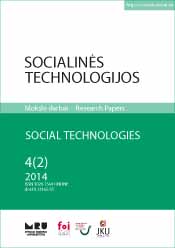KŪRYBINGUMO UGDYMAS – INVESTICIJA Į KŪRYBINĘ VISUOMENĘ
DEVELOPMENT OF CREATIVITY – AN INVESTMENT TO THE CREATIVE SOCIETY
Author(s): Edita Dalia RakauskaitėSubject(s): Social Sciences
Published by: Mykolas Romeris University
Keywords: creativity; art; personality; visual expression.
Summary/Abstract: Purpose – Given the importance of the modern creative society, revealing the need for creativity in personality of education as a spiritual and intellectual elite exclusiveness, the role of visual expression, art, culture, historical knowledge and contemporary features, the teacher has the creator’s role of creativity in education in higher education institutions in Lithuania. Design/methodology/approach – Scientist literature reveals that creativity is the learner’s property and for that purpose, the universities adapt their original and innovative teaching and learning methods. Based on the case study, the author of this paper discusses the role of visual expression in fostering creativity, creative methods of education, and looks at Mykolas Romeris University subject’s called “Creativity ability and activities” curriculum. Findings – Creativity is not the exclusive property of talented people, but it is also available to each individual. Education and training can be an incentive and an obstacle to creativity. It is, therefore, necessary to create and adapt individual and original teaching and learning methods and an inquisitive society. A variety of methods is important in creative education. Education of art is the best way to reveal personal creativity. Teachers are artists, who provide a professional approach to their subject area. They are anexample of their life and work for a young person, the names of their famous universities in artistic creation, which is equivalent to faculty research scientists work. Research limitations/implications – The article provides an overview of only one subject in “Creativity ability and activities” methodology of creativity in the educational process. In addition, feedback of only one course student is included (N-90). Practical implications – In the creative process, students would see a positive selfassessment of their individual personality sides, understanding their own and other unique recognition and evaluation of self-discipline, emotional scale of the development and transfer of ideas, communication skills, ability to solve proble
Journal: Socialinės Technologijos
- Issue Year: 4/2014
- Issue No: 02
- Page Range: 333-347
- Page Count: 15
- Language: Lithuanian

